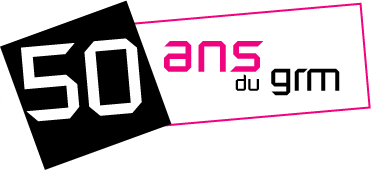

  |
The Musical Research Group of the National Audiovisual Institute of France is a unique centre founded in 1958 by Pierre Schaeffer and dedicated to research, creation and conservation of electroacoustic music.
The GRM develops towards composers, sound designers and anyone interested in sound processing, a series of innovative tools for sound representation and analysis (Acousmographe) and sound processing (GRM Tools) which are today recognised by all.
Its concert series “Multiphonies”, programmed every year since 1978 at the Salle Olivier Messiaen at the French Radio building, gives the occasion to more than twenty composers every year, coming from different horizons and aesthetics, to experiment the tools and to present their creations done in the GRM Studios with its unique tool: the Acousmonium.
This rich musical heritage is available through the largest CD collection dedicated to Electroacoustic Music initiated in 1984 (more than 100 references), and is regularly presented through radio programs in France Musique and France Vivace (more information at www.ina.fr)
The adventure of the GRM started 10 years earlier, in 1948, when Pierre Schaeffer invents the Musique Concrète, and invents a second very important concept; musical research, as a way to comprehension of the musical phenomenon and the discovery of new means that lead to musical creation.
Pierre Schaeffer opened the road to using any sound phenomena within musical creation. Road followed some time late by Elektronische Musik in Germany and which lead at the beginning of the sixties to the concept of Electroacoustic Music.
In 1972, François Bayle, then director of GRM, introduced the concept of Acousmatic Music, designing any music in which the causes are invisible to the listener. Music on a media, that uses the loud-speaker as a conveyor and may eventually include instruments for its performance. Music of images, music for the imagination, a world repertoire of more than 30,000 works, 1,500 of which where composed in the GRM studios. These numbers show the impact that Electroacoustic Music has had on composers and gives and the extraordinary creation strength it still has. Electroacoustic Music is one of the richest forms of musical expression and proposes to our listening all the possible sounds and all the ways in which sounds combine to create forms and structures for our perception.
A unique tool was conceived to present this music within a concert situation, the Acousmonium, large loudspeaker orchestra that may contain up to 80 loudspeakers. This unique tool permits to perform music in different spaces and volumes, permitting the best perception for a large audience of the musical phenomena. Since it was first conceived, in 1974, more than 370 concerts have been done with the Acousmonium, in France and in almost all European countries. More than 1200 works from 360 composers have been presented, most of them as world premières.
Thus, a rich tradition, diverse and active, gives the measure of the importance of Electroacoustic and Acousmatic Music in today’s musical life. It is a musical trend that will remain as one of most extraordinary achievements of the Twentieth Century.
Piano is strongly embedded in the history of Musique Concrète and Acousmatic Music. The first work composed by Pierre Schaeffer called “Étude violette” was mainly done on piano sounds. The piano remained as one of the favourite instruments for Schaeffer and Pierre Henry, since it contained the essentials of the musique concrete Studio: it could produce a very large variety of sounds and it had an embedded reverberation!
It has since then remained as a very strong attractor to composers, who have regularly explored its richness and diversity and the face that all listeners have a high knowledge of piano sounds and can thus follow the complex paths of its transformation and accumulation with other sounds. It continues to be an experimental studio where so different and diverse attitudes can be found.
The strength of the piano as an experimental tool is not a new issue for the instrument. At the beginning of the Twentieth Century it was an experimental tool for the new trends that where explored by composers like Debussy and Ravel, but also by Schonberg in his quest for a new melodic system. Its immediate approach for the composer, its functional organisation as a reduced orchestra, its huge variety of colours, has given to the piano a special status among composers and listeners.
An equivalence can be found between Claude Debussy and Pierre Schaeffer and Pierre Henry in their quest for new sounds, new colours, new forms that would challenge musical imagination and propose new listening worlds while keeping the sound within a known realm.
A century of piano music is behind us; with all the possible forms of use, combination and character. Impressionism, modernism, serialism, jazz, contemporary music, electroacoustic music have continuously explored the possibilities of its sound. Thousands of works have paved our repertoire and renewed with the possibilities of the instrument. Nevertheless, it still remains, and will remain as the predilection instrument for exploring new roads, new sounds and new perspectives for our mind.
Daniel Teruggi
Director of GRM